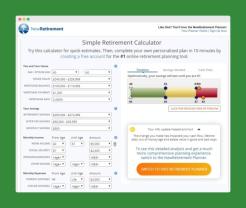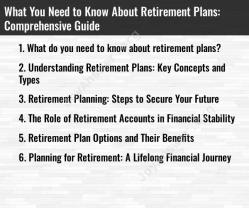What is a simple plan for retirement?
Creating a basic retirement plan involves a few key steps:
Set Retirement Goals: Determine the lifestyle you envision during retirement. Consider factors like where you'll live, desired activities, and estimated expenses.
Calculate Retirement Needs: Estimate the amount needed for retirement based on your lifestyle goals. Consider expenses like housing, healthcare, daily living, and any desired activities.
Start Saving Early: Begin contributing to retirement accounts as soon as possible. Take advantage of employer-sponsored plans like 401(k)s or individual retirement accounts (IRAs). Aim to save a percentage of your income regularly.
Maximize Employer Contributions: If your employer offers a matching contribution to retirement accounts, contribute at least enough to receive the maximum match. It's essentially free money that boosts your retirement savings.
Diversify Investments: Spread investments across different asset classes (stocks, bonds, real estate) to manage risk. Consider your risk tolerance and adjust investments accordingly as you near retirement.
Reduce Debt: Aim to pay off high-interest debts, like credit cards, before retirement. Reducing debt minimizes financial stress and allows more funds to be allocated to retirement savings.
Create a Budget: Track expenses and create a budget to control spending. This helps ensure that you're saving adequately for retirement while managing current finances.
Consider Long-Term Care Insurance: Evaluate the need for long-term care insurance. It can protect savings from being depleted due to medical or care expenses later in life.
Regularly Review and Adjust: Periodically review your retirement plan. Adjust contributions, investments, or goals as circumstances change, such as changes in income, family situations, or market conditions.
Plan for Social Security: Understand how Social Security benefits work and consider the best time to start receiving benefits based on your financial situation.
Remember, this is a simplified blueprint. Consulting a financial advisor can provide personalized guidance based on your specific circumstances, ensuring a more tailored and effective retirement plan.
Essential Steps to Create a Retirement Savings Plan:
Here are some essential steps to create a retirement savings plan:
1. Define your retirement goals:
- Desired retirement age: When do you envision retiring?
- Desired lifestyle: What lifestyle do you want to maintain in retirement?
- Estimated retirement expenses: Calculate your anticipated monthly and annual expenses in retirement.
- Estimated retirement income: Estimate your income from Social Security, pensions, and other sources.
2. Assess your current financial situation:
- Current income: Analyze your salary, any side hustles, and other sources of income.
- Current expenses: Track your spending habits and identify areas for potential savings.
- Existing debts: List your outstanding debts and their associated interest rates.
- Current assets: Calculate your total savings, investments, and other assets.
3. Choose retirement savings accounts:
- Employer-sponsored plan: Contribute to your employer-sponsored retirement plan, like a 401(k) or 403(b), to benefit from employer matching contributions and tax advantages.
- Individual Retirement Accounts (IRAs): Consider an IRA if you don't have an employer-sponsored plan or want to supplement your retirement savings. There are various IRA options, each with different contribution limits and tax implications.
- Additional investments: Explore other investment options like stocks, bonds, and mutual funds to further diversify your portfolio.
4. Determine your savings rate:
- Calculate the gap between your desired retirement income and your estimated income from other sources.
- Use a retirement calculator or consult a financial advisor to determine the required savings rate based on your age, desired retirement age, investment returns, and other factors.
- Aim to increase your savings rate over time as your income grows.
5. Automate your savings:
- Set up automatic transfers from your checking account to your retirement savings accounts.
- This ensures consistent contributions and helps you avoid the temptation to spend the money.
6. Rebalance your portfolio regularly:
- Regularly review your investment portfolio and rebalance it as needed to maintain your desired asset allocation.
- This helps manage risk and ensure your portfolio aligns with your changing risk tolerance and time horizon.
7. Seek professional guidance:
- Consider consulting a financial advisor for personalized advice on creating a retirement savings plan that aligns with your specific goals and financial situation.
Creating a Straightforward and Effective Retirement Strategy:
- Focus on simplicity: Choose investment options you understand and manage easily.
- Invest for the long term: Don't get swayed by short-term market fluctuations.
- Diversify your portfolio: Spread your investments across different asset classes to manage risk.
- Control your expenses: Prioritize saving and minimize unnecessary expenditures.
- Review your plan regularly: Adapt your plan as needed based on life changes and market conditions.
By taking these steps, you can create a straightforward and effective retirement strategy that increases your confidence and chances of a financially secure retirement.
Additional resources:












